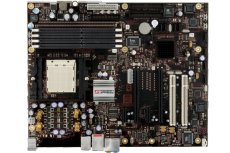 Introduction
Introduction

Eleven months ago, NVIDIA
announced the return of SLI, a very familiar concept to those that
remember 3dfx and, specifically, the Voodoo 2. Whilst NVIDIA's SLI had a
reasonable gestation period before end users could adopt it, the concept has
taken off fairly well since the release of NVIDIA's nForce4 SLI chipset
platform.
With the "capture the flag" mentality surrounding performance 3D graphics it was inevitable that ATI would have to respond at some point because regardless of who has the highest single board performance, with two high end boards in a system the "who has the fastest solution" advantage was often going to go in NVIDIA’s favour by virtue of SLI. To that end ATI are now ready to announce their own multi-rendering graphics solution which they have dubbed "CrossFire".
ATI are keen to point out that, although they were behind NVIDIA in introducing a Multi-Board platform on current generations of technologies, they do have some heritage in this particular field. For starters, ATI produced the ill fated Rage Fury MAXX, which utilised two Rage 128 Pro chips on a single board; this was coupled with a rendering system that ATI called AFR (alternate frame rendering), a mode that NVIDIA also adopted for their SLI platform. More recently ATI have worked with Evens & Sutherland and SGI who produce graphics render-farms with numerous Radeon 9700 or 9800 chips inside a single system all assisting in rendering either very high resolution images or images with very high levels of FSAA - in their highest implementation Evans & Sutherland utilise up to 64 graphics chips in a single "RenderBeast" system. Desktop graphics processors built by ATI from R300 and upwards have a number of hardware elements that were specifically designed with scaleable, multi-chip rendering in mind, and the CrossFire system ATI have put in place for their multi-board desktop platform presses these into service, and even elements from MAXX are utilised.
Fundamentally, though, ATI’s CrossFire solution is similar to NVIDIA’s – in its initial form it uses a motherboard that supports two 16x PCI Express for graphics slots and couples two graphics boards together in order to increase the potential rendering performance over a single board. However, beyond that many of the details differ and we'll take a short look at the details here.
CrossFire Hardware
Platform
As with NVIDIA's SLI platform there are two elements to the hardware in order to support multi-board rendering: the platform and the graphics cards. Platform wise ATI themselves are introducing new chipset variants of the Radeon XPRESS 200 platforms, one for AMD and one for Intel systems, RD480 and RD400 respectively, known as the "Radeon XPRESS 200 CrossFire Edition". The platforms have been tweaked to support multiple 16x graphics slots, by splitting the 16 lanes from the primary 16x connector and distributing them across the two connectors with 8 lanes going to each, much the same as NVIDIA's nForce4 SLI platform. ATI's reference platforms use an electronic switch lane distribution so that the user doesn't have to reconfigure the motherboard to support two graphics boards by changing a selector card or reconfiguring jumpers; with an electronic switch the lane distribution can occur via software.
Both the new ATI's platforms for CrossFire have gone through a minor upgrade since the initial introduction of Radeon XPRESS 200 in that ATI now have their own Southbridge that supports Azalia High Definition Audio. As there have been no other alterations to the platforms, ATI are pushing their vendors to support GigaBit Ethernet chips, connected to the Northbridge via the PCI Express, and additional Silicon Image SATA II disk controllers with NCQ and RAID. ATI's own platforms face fairly stiff competition in the face of the feature rich nForce4 platform, however in conjunction with the extra functionality added to their chipsets that expect vendors to support, they are keen to stress the overclocking capabilities of their platforms, something that they are beginning to generate a bit of a name for themselves with - when so many game titles are CPU bound, having the capability to squeeze out a little extra performance from the platform is likely to be beneficial with two graphic boards in operation.
On this initial introduction, although somewhat evasive on an actual reply, ATI look to be initially making CrossFire applicable to their platforms only, something that we hope they will soon readdress and offer the capability on other platforms that can support splitting of the PCI Express graphics system into two 8x lanes. Ostensibly it would seem like there should be little stopping ATI from operating on nForce4 SLI platforms and there are far more of these already currently in use.


